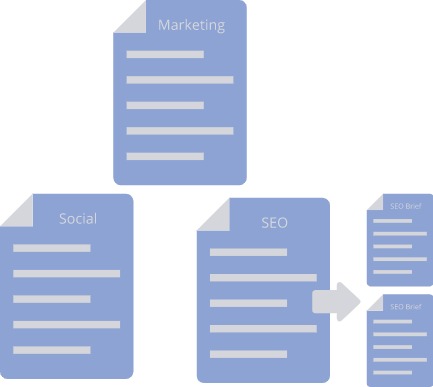10 Steps for Creating an SEO Marketing Plan [Template Included]
Last updated 4/9/2020
What is an SEO marketing plan and how does it relate to the overall marketing plan?
While most businesses have marketing plans, these plans rarely detail how search engine optimization (SEO) should support overall marketing goals. Nor should they. These plans are meant to provide a high-level overview of an organization’s marketing goals and the main initiatives needed to achieve those goals.
So, how should an SEO team set goals and initiatives to support this marketing plan?
Let me introduce you to the concept of an SEO marketing plan. An SEO marketing plan distills a marketing plan down to only the elements necessary to perform SEO. For example, the list of marketing channels and known competitors. It then adds additional elements to guide an SEO team’s efforts throughout the year. For example, a list of SEO initiatives.
The image below shows how this document relates to the marketing plan, other channel-specific marketing plans, and SEO project briefs, which further break down initiatives or projects described in the SEO marketing plan.

Is it worth the work?
This depends on the amount and diversity of work. Here are some benefits to determine whether it is worth pursuing for your team:
- Planning – Plan SEO goals and initiatives in the context of larger marketing and organizational goals.
- Organization – Create a place of structure in the chaos of most organizations.
- Focus – Prevent time spent on efforts that do not support overall marketing goals.
- Transparency – Showcase your plans to clients and other teams.
- Onboarding – Quickly inform someone of the SEO marketing plans for the year.
Filling out the SEO marketing plan
General guidelines:
- Start by requesting the marketing plan from your clients. You can migrate most of this to the SEO marketing plan.
- You do not need to complete it all at once. You should fill it out as you learn more about the product and client.
1) Provide a brief overview of the product
What is being sold? Who is buying it? Why are they buying it?
Example: Selling hammers to construction workers who use them to build houses.
What is the unique value proposition?
What makes your product unique? Why would someone buy your product over another product?
Brand identity
If this brand was a person, what words would describe him/her?
What are taglines or slogans used to promote the brand?
How does the brand make someone’s life better beyond the functional aspects of the product?
2) Identify your target market
You can spend years segmenting your audience. This is something you can build over time. Start with identifying at least one audience and then continue from there.
For each audience, identify the following:
Overview
Create a two to three sentence description of your audience referencing factors such as their interests, lifestyle, and habits.
Challenges
What challenges does this audience experience that your product addresses?
What they value in a product
What does this audience value when shopping for a product you offer?
3) Identify competitors
For each main competitor, identify the following:
Unique selling proposition(s)
What makes their product unique? Why would someone buy their product over another product?
Branding
If this brand was a person, what words would describe him/her?
What are taglines or slogans used to promote the brand?
How does the brand make someone’s life better beyond the functional aspects of the product?
4) Outline the marketing ecosystem
What are all the ways someone could experience your marketing? This can include your website, organic search, paid search, display, the list can go on for a while…
| Channel | Presence? |
|---|---|
| Web | |
| App | |
| Paid Search | |
| Organic Search | |
| Paid Social | |
| Organic Social | |
| Online Video (OLV) | |
| TV | |
| Digital Radio | |
| Traditional Radio |
5) What are the marketing goals SEO can influence?
These are not SEO goals. These are goals from the overall marketing plan SEO teams can influence. For example, “launch site X at X date to improve the conversion rate by X%.”
6) What SEO initiatives will help achieve these marketing goals?
What are the initiatives that will help achieve the marketing goals above? Examples include keyword research, SEO technical audits, and market research.
7) What is your budget?
In terms of time and money.
8) Who are the marketing stakeholders?
Who will be involved in the marketing initiatives above?
9) What resources can help achieve the marketing goals?
Examples can include keyword research and technical audits.
10) Revisit and revise on a constant basis
You do not need to read through the entire SEO marketing plan every week. However, I recommend reviewing at least the marketing goals and SEO initiatives portion weekly to maintain focus.
Now go make the world a better place!
An SEO marketing plan allows you to accomplish more with less effort. The effort reduction contributes to a calm working environment, providing more enjoyment inside and outside of work.